Assessment of Residents’ Exposure to Leisure Noise in Málaga (Spain)
Abstract
:1. Introduction
The Case of Málaga
2. Objectives
- To compare different locations and areas with the goal of establishing priorities for action plans;
- To determine where the noise occurs at each location during workdays and weekends;
- To raise noise awareness at all levels of society (bar, pub, and restaurant owners and patrons, residents, and authorities);
- To give support to any mitigation action that could affect owners, users, or residents;
- To determine the amount of reduction required in each area;
- To assess the “before condition” to improve the later evaluations of the efficacy of the mitigation measures.
3. Methodology
3.1. Planning and Sensor Network
3.2. Analysis
3.2.1. Acoustic Description over the Long Term
3.2.2. Daily Acoustic Description
3.2.3. Weekly and Daily Noise Patterns
3.3. Discussion of the Measurement Results and Prediction Models
- The levels of noisy activities change throughout the evening and nighttime periods, but the variables in the models remain fixed. This is an issue that we cannot fix using a correction factor;
- The models do not envisage the effect of the duration of noisy activities or their variability; therefore, it is not possible to estimate the reference indicators Ld, Le, and Ln (over either the short or long term);
- The noise levels during a leisure period in a location can fluctuate by more than 6 dBA (LAeq,1h). This variability may be even higher when estimating the duration to calculate Ld, Le or Ln;
- A simulation, even if accurate and precise, is difficult for residents to relate to, and using one would likely cause complaints. Instead, a web-accessible noise-monitoring system will comply much better with the engagement objectives.
3.4. Public Engagement
3.4.1. Website
- Real-time web access to the measurements. To better engage with visitors, the measurement data were published in a line chart and updated each second. Additionally, the page contained the geolocation of each noise monitor, information about the installation, and information about noise indicators for the daytime (Ld), evening (Le), nighttime (Ln), and day–evening–night (Lden) periods. The structure of the webpage can be seen in Figure 7;
- Noise indicators. The noise indicators for the daytime (Ld), evening (Le), and nighttime (Ln) periods appeared in reports generated in response to users’ queries and could be compared to regulation noise levels.
3.4.2. Online Survey and Polls
- Do you exhibit noisy behavior?
- What time do you go to sleep on a workday?
- Have you ever used earplugs to sleep?
- Social and demographic data: Respondents were asked about their gender, age, and city. The participants from Málaga had to specify their district and neighborhood;
- Participants’ dwelling: The participants were asked to provide some information about their dwelling, such as time of residence and the acoustic insulation of their house;
- Participants’ relation with noise: This section described the participants’ perceptions of the noise in their neighborhood and the annoyance produced by different noise sources;
- All noise sources in the neighborhood: The participants were asked to provide information about the effect of noise in their lives and the actions they have undertaken to mitigate noise;
- Specific noise sources: The participants were asked to select the noise source (road, rail, air traffic, leisure, neighbors, etc.) that is most disturbing for them when they are at home. The questions in this section were focused on the specific noise source they selected, trying to identify the most disturbing activities and periods;
- Noise-monitoring system: The participants from Málaga were asked to rate the noise-monitoring system installed in the city.
3.4.3. Result of the Engagement Activities
Survey Results
Results of the other Engagement Activities
4. Noise Impact Assessment
5. Conclusions
Author Contributions
Acknowledgments
Conflicts of Interest
References
- World Health Organization. Guidelines for Community Noise; World Health Organization: Geneva, Switzerland, 1999; ISBN 9789971887704. [Google Scholar]
- Passchier-Vermeer, W. Noise and Health; Health Council of the Netherlands: The Hague, The Netherlands, 1993; ISBN 90-5549-025-3. [Google Scholar]
- Passchier-Vermeer, W.; Passchier, W.F. Noise Exposure and Public Health. Environ. Health Perspect. 2000, 108, 123–131. [Google Scholar] [CrossRef] [PubMed]
- World Health Organization. Night Noise Guidelines for Europe; World Health Organization Europe: Copenhagen, Denmark, 2009; ISBN1 9789289041737. ISBN2 9289041730. [Google Scholar]
- Miedema, H.M.E.; Vos, H. Exposure-response relationships for transportation noise. J. Acoust. Soc. Am. 1998, 104, 3432–3445. [Google Scholar] [CrossRef] [PubMed]
- Paunovic, K.; Belojevic, G.; Jakovljevic, B. Noise annoyance is related to the presence of urban public transport. Sci. Total Environ. 2014, 481, 479–487. [Google Scholar] [CrossRef] [PubMed]
- Suau-Sanchez, P.; Pallares-Barbera, M.; Paül, V. Incorporating annoyance in airport environmental policy: Noise, societal response and community participation. J. Transp. Geogr. 2011, 19, 275–284. [Google Scholar] [CrossRef] [Green Version]
- Laszlo, H.E.; McRobie, E.S.; Stansfeld, S.A.; Hansell, A.L. Annoyance and other reaction measures to changes in noise exposure—A review. Sci. Total Environ. 2012, 435–436, 551–562. [Google Scholar] [CrossRef] [PubMed]
- European Parliament. Directive 2002/49/EC of the European Parliament and of the Council of 25 June 2002 Relating to the Assessment and Management of Environmental Noise; European Parliament: Brussels, Belgium, 2002. [Google Scholar]
- Gajardo, C.P.; Morillas, J.M.B.; Escobar, V.G.; Vílchez-Gómez, R.; Gozalo, G.R. Effects of singular noisy events on long-term environmental noise measurements. Pol. J. Environ. Stud. 2014, 23, 2007–2017. [Google Scholar]
- World Health Organization. Environmental Noise Guidelines for the European Region; World Health Organization Europe: Copenhagen, Denmark, 2018; ISBN 9789289053563. [Google Scholar]
- Tung, C.-Y.; Chao, K.-P. Effect of recreational noise exposure on hearing impairment among teenage students. Res. Dev. Disabil. 2013, 34, 126–132. [Google Scholar] [CrossRef]
- Serra, M.R.; Biassoni, E.C.; Skarp, A.H.O.; Serra, M.; Joekes, S. Sound immission during leisure activities and auditory behaviour. Appl. Acoust. 2007, 68, 403–420. [Google Scholar] [CrossRef]
- Axelsson, A. Leisure noise exposure in adolescents and young adults. J. Sound Vib. 1991, 151, 447–453. [Google Scholar] [CrossRef]
- Butterfield, D. Research Report RR517–Measurement of Noise Levels that Staff are Exposed to at Live Music Events; Health and Safety Executive: London, UK, 2006. [Google Scholar]
- Peters, R. The role of hearing protectors in leisure noise. Noise Heal. 2003, 5, 47–55. [Google Scholar]
- Dalton, D.S.; Cruickshanks, K.J.; Wiley, T.L.; Klein, B.E.K.; Klein, R.; Tweed, T.S. Association of Leisure-Time Noise Exposure and Hearing Loss. Audiol. J. Audit. Commun. 2001, 40, 1–9. [Google Scholar]
- Dehnert, K.; Raab, U.; Perez-Alvarez, C.; Steffens, T.; Bolte, G.; Fromme, H.; Twardella, D. Total leisure noise exposure and its association with hearing loss among adolescents. Int. J. Audiol. 2015, 54, 665–673. [Google Scholar] [CrossRef] [PubMed]
- Gilliver, M.; Beach, E.F.; Williams, W. Changing beliefs about leisure noise: Using health promotion models to investigate young people’s engagement with, and attitudes towards, hearing health. Int. J. Audiol. 2015, 54, 211–219. [Google Scholar] [CrossRef] [PubMed]
- Beach, E.F. Leisure Noise and Hearing. Semin. Hear. 2017, 38, 263–265. [Google Scholar] [CrossRef] [PubMed]
- Fiamini, F.; Luzzi, S. Monitoring and reducing noise related to Movida: Real cases and smart solutions. In Proceedings of the 22nd International Congress on Sound and Vibration 2015 (ICSV 22), Florence, Italy, 12–16 July 2015; pp. 1959–1965. [Google Scholar]
- Ottoz, E.; Rizzi, L.; Nastasi, F. Recreational noise in Turin and Milan: Impact and costs of movida for residents. In Proceedings of the 22nd International Congress on Sound and Vibration 2015 (ICSV 22), Florence, Italy, 12–16 July 2015. [Google Scholar]
- Ottoz, E.; Rizzi, L.; Nastasi, F. Recreational noise: Impact and costs of movida for disturbed residents in Italy. In Proceedings of the 45th International Congress and Exposition on Noise Control Engineering: Towards a Quieter Future (INTER-NOISE 2016), Hamburg, Germany, 21–24 August 2016; pp. 7284–7293. [Google Scholar]
- Ottoz, E.; Rizzi, L.; Nastasi, F. Recreational noise: Impact and costs for annoyed residents in Milan and Turin. Appl. Acoust. 2018, 133, 173–181. [Google Scholar] [CrossRef]
- Vinci, B.; Tonacci, A.; Caudai, C.; De Rosa, P.; Nencini, L.; Pratali, L. The SENSEable Pisa Project: Citizen-Participation in Monitoring Acoustic Climate of Mediterranean City Centers. Clean Soil Air Water 2017, 45. [Google Scholar] [CrossRef]
- Ballesteros, M.J.; Fernández, M.D.; Flindell, I.; Torija, A.J.; Ballesteros, J.A. Estimating leisure noise in Spanish cities. Appl. Acoust. 2014, 86, 17–24. [Google Scholar] [CrossRef]
- Ballesteros, M.J. Análisis del Ruido de Ocio, Propuesta de Procedimientos y Herramientas de Gestión. Ph.D. Thesis, Universidad Politécnica de Madrid, Madrid, Spain, 24 November 2014. [Google Scholar]
- Ballesteros, M.J.; Fernández, M.D.; Ballesteros, J.A. Acoustic evaluation of leisure events in two mediterranean cities. Appl. Acoust. 2015, 89, 288–296. [Google Scholar] [CrossRef]
- Sound Solution Consultants. The Black Horse Festival Noise Impact Assessment; Sound Solution Consultants: Colchester, UK, 2010. [Google Scholar]
- Lakin, C.; Brown, S.; Williams, M. Noise monitoring at Glastonbury Festival. Noise Vib. Worldw. 2001, 32, 12–14. [Google Scholar] [CrossRef]
- Garg, N.; Sinha, A.K.; Gandhi, V.; Bhardwaj, R.M.; Akolkar, A.B. A pilot study on the establishment of national ambient noise monitoring network across the major cities of India. Appl. Acoust. 2016, 103, 20–29. [Google Scholar] [CrossRef]
- Defensor del Pueblo. Informe Anual 2015 y Debates en las Cortes Generales. 2015. Available online: https://www.defensordelpueblo.es/wp-content/uploads/2016/02/Informe2015.pdf (accessed on 27 November 2018).
- Fernández, E. Percepción del Ruido por los Ciudadanos de Málaga. 3a Encuesta. 2012. Available online: http://controlderuido.malaga.eu/opencms/export/sites/ctrlruido/.content/documentos/documentos-general/Memoria-Tecnica-final-Dic2008.pdf (accessed on 27 November 2018).
- Sincosur. Documento Información Pública—Servicio de Consultoría y Asistencia Técnica Relativa a la Revisión y Actulización de los Planes de Acción Contra el Ruido en Málaga. 2015. Available online: http://sicaweb.cedex.es/docs/planes/Fase2/Aglomeraciones/PAR_MALAGA.pdf (accessed on 27 November 2018).
- Ayuntamiento de Málaga. Observatorio Turístico de la Ciudad de Málaga 2009. 2009. Available online: http://s3.malagaturismo.com/files/96/96/observatorio2009.pdf (accessed on 27 November 2018).
- Ayuntamiento de Málaga. Observatorio Turístico de la Ciudad de Málaga Noviembre 2014–Octubre 2015. 2015. Available online: http://s3.malagaturismo.com/files/327/327/noviembre2014-octubre2015.pdf (accessed on 27 November 2018).
- DonDeNegocios Geomarketing. Comercio y Hostelería en el Centro de Málaga 2001–2017. 2017. Available online: https://www.dondenegocios.com/single-post/Mapa-Comercio-Hosteleria-Centro-Malaga-2001-2017 (accessed on 27 November 2018).
- Ayuntamiento de Málaga. Mapa de Trabajo Social de Málaga 2012. Volumen 1. Distrito Málaga Centro. 2012. Available online: http://www.malaga.eu/recursos/sociales/observatorio/descargas/mapa_trabajo_social/distrito1.pdf (accessed on 27 November 2018).
- Gutiérrez, A. El centro histórico de Málaga: Perspectiva de su recuperación. VIVA LA CALLE las actuaciones de revitalización del centro histórico de Málaga desde 1994 a 2005. 2005. Available online: http://www.programaseuropeos-malaga.com/subidas/archivos/arc_2094.pdf (accessed on 27 November 2018).
- Ayuntamiento de Málaga. Análisis de la Población en el Ámbito del PEPRI Centro. 2010. Available online: http://www.programaseuropeos-malaga.com/subidas/archivos/arc_2322.pdf (accessed on 27 November 2018).
- Marín, P. El Proceso de Urbanicación de la Ciudad, Compactar la Dispersión Urbana. 2015. Available online: http://www.omau-malaga.com/agenda21/subidas/archivos/arc_99.pdf (accessed on 27 November 2018).
- Ayuntamiento de Málaga. Mapa de Trabajo Social de Málaga 2012. Volumen 11. Distrito Teatinos-Universidad. 2012. Available online: http://observatoriosocial.malaga.eu/opencms/export/sites/observasocial/.galeria-descargas/Mapa-trabajo-social/volumen11/DISTRITO-11-TEATINOS-UNIVERSIDAD.pdf (accessed on 27 November 2018).
- Asensio, C.; De Arcas, G.; López, J.M.; Pavón, I.; Gascó, L. Awareness: A parallel approach against noise. In Proceedings of the 22nd International Congress on Sound and Vibration (ICSV 22), Florence, Italy, 12–16 July 2015; pp. 12–16. [Google Scholar]
- Gasco, L.; Asensio, C.; de Arcas, G. Communicating airport noise emission data to the general public. Sci. Total Environ. 2017. [Google Scholar] [CrossRef] [PubMed]
- International Organization for Standardization. ISO 1996-2:2007 Acoustics—Description, Measurement and Assessment of Environmental Noise—Part 2: Determination of Environmental Noise Levels; International Organization for Standardization: Geneva, Switzerland, 2007. [Google Scholar]
- Boletin Oficial del Estado. Real Decreto 1367/2007, de 19 de Octubre, por el que se Desarrolla la Ley 37/2003, de 17 de Noviembre, del Ruido, en lo Referente a Zonificación Acústica, Objetivos de Calidad y Emisiones Acústicas; Boletin Oficial del Estado: Madrid, Spain, 2007. [Google Scholar]
- Mietlicki, C.; Mietlicki, F.; Ribeiro, C.; Gaudibert, P.; Vincent, B. The HARMONICA project, new tools to assess environmental noise and better inform the public. In Proceedings of the Forum Acusticum Conference, Krakow, Poland, 7–12 September 2014. [Google Scholar]
- Hamburg Airport Hamburg Airport Noise Monitoring System. Available online: http://travisham.topsonic.aero/ (accessed on 27 November 2018).
- EveryAware Widenoise Webpage. Available online: http://cs.everyaware.eu/event/widenoise (accessed on 16 June 2016).
- European Environmental Agency. NoiseWatch Page. Available online: https://www.eea.europa.eu/themes/human/noise/noise-story-map (accessed on 16 June2016).
- Notley, H.; Grimwood, C.; Raw, G.; Clark, C.; Zepidou, G.; Van de Kerckhove, R.; Moon, N. National Noise Attitude Survey 2012; Department for Environment, Food and Rural Affairs: London, UK, 2014.
- Arana, M.; García, A. A social survey on the effects of environmental noise on the residents of Pamplona, Spain. Appl. Acoust. 1998, 53, 245–253. [Google Scholar] [CrossRef]
- Martín, M.Á.; Tarrero, A.I.; Machimbarrena, M.; González, J.; de Garibay, V.G. A methodology to study noise annoyance and to perform Action Plans follow up using as input an existing survey and noise map: Application to the city of Málaga (Spain). Appl. Acoust. 2011, 72, 495–504. [Google Scholar] [CrossRef]
- QuestionPro Website. Available online: https://www.questionpro.com/es/ (accessed on 20 November 2018).
- Bluhm, G.; Nordling, E.; Berglind, N. Road traffic noise and annoyance—An increasing environmental health problem. Noise Health 2004, 6, 43–49. [Google Scholar] [PubMed]
- Sincosur. Estudio Técnico para la Declaración de Zonas Acústicas Especiales en Málaga y Plan Zonal Específico. 2016. Available online: http://medioambiente.malaga.eu/opencms/export/sites/sostenibilidad/.content/galerias/Zonas-acusticamente-saturadas/estudio-tecnico-parte1.pdf (accessed on 27 November 2018).
- Sincosur. Revisión y Actualización de los Planes de Acción Contra el Ruido en Málaga. 2015. Available online: http://controlderuido.malaga.eu/opencms/export/sites/ctrlruido/.content/documentos/documentos-general/II_PAR_MEMORIA.pdf (accessed on 27 November 2018).
- Ayuntamiento de Málaga. Propuesta Relativa a la Declaración de Determinadas Zonas del Centro y Teatinos como zonas de Protección Acústica Especial. 2018. Available online: http://medioambiente.malaga.eu/opencms/export/sites/sostenibilidad/.content/galerias/documentos/ACUERDO-JGL-DE-27-SEPT-2018.pdf (accessed on 27 November 2018).
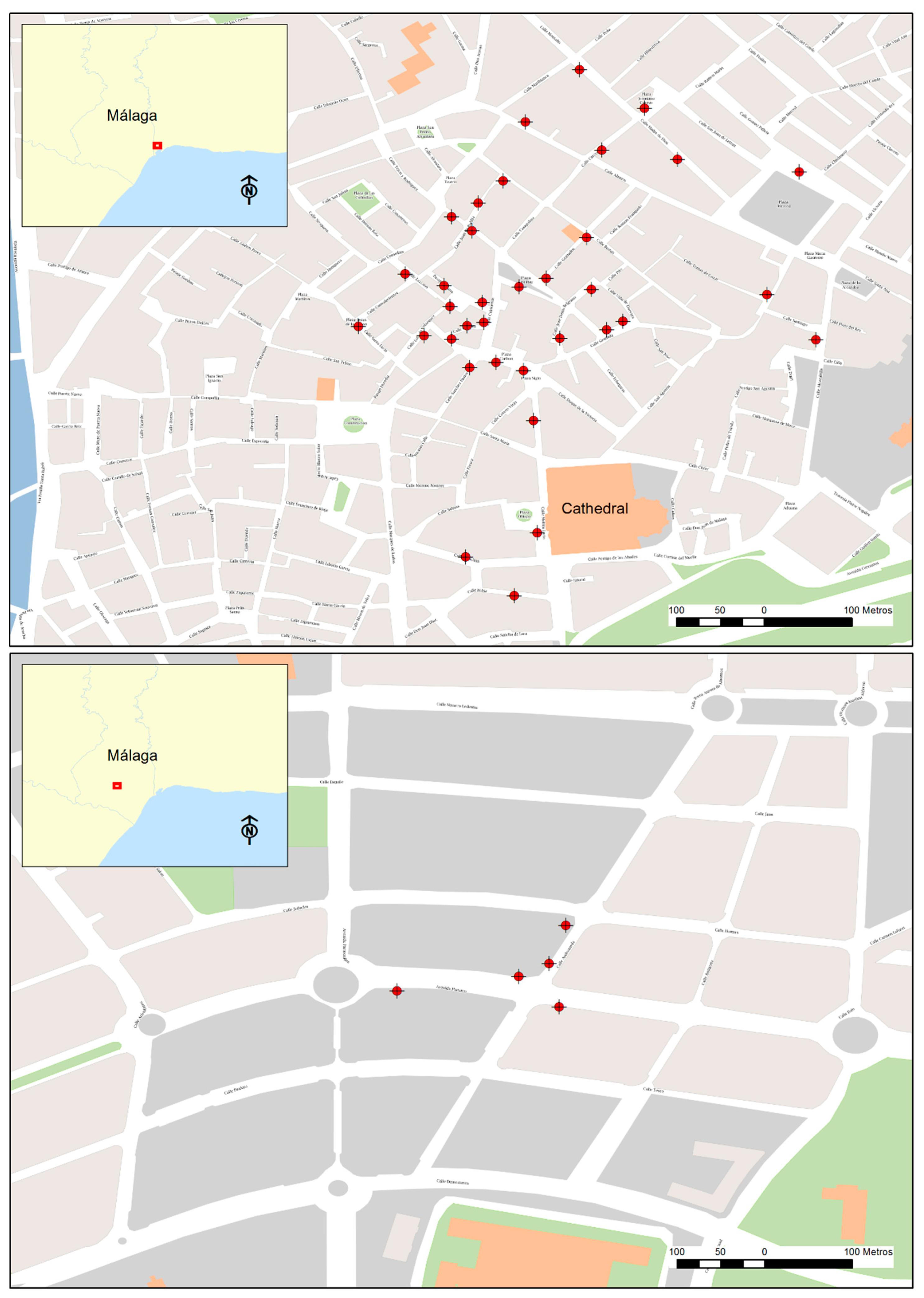
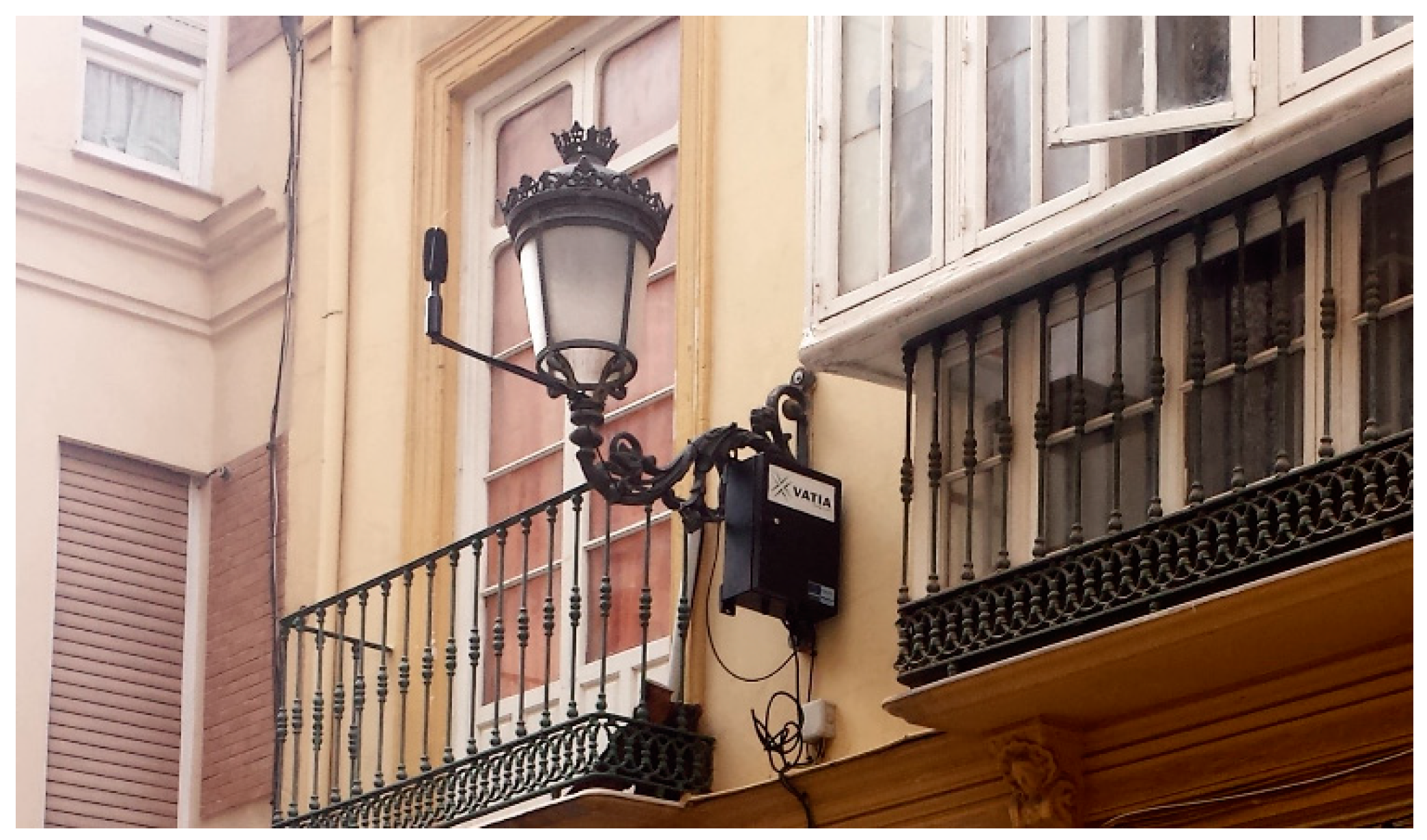
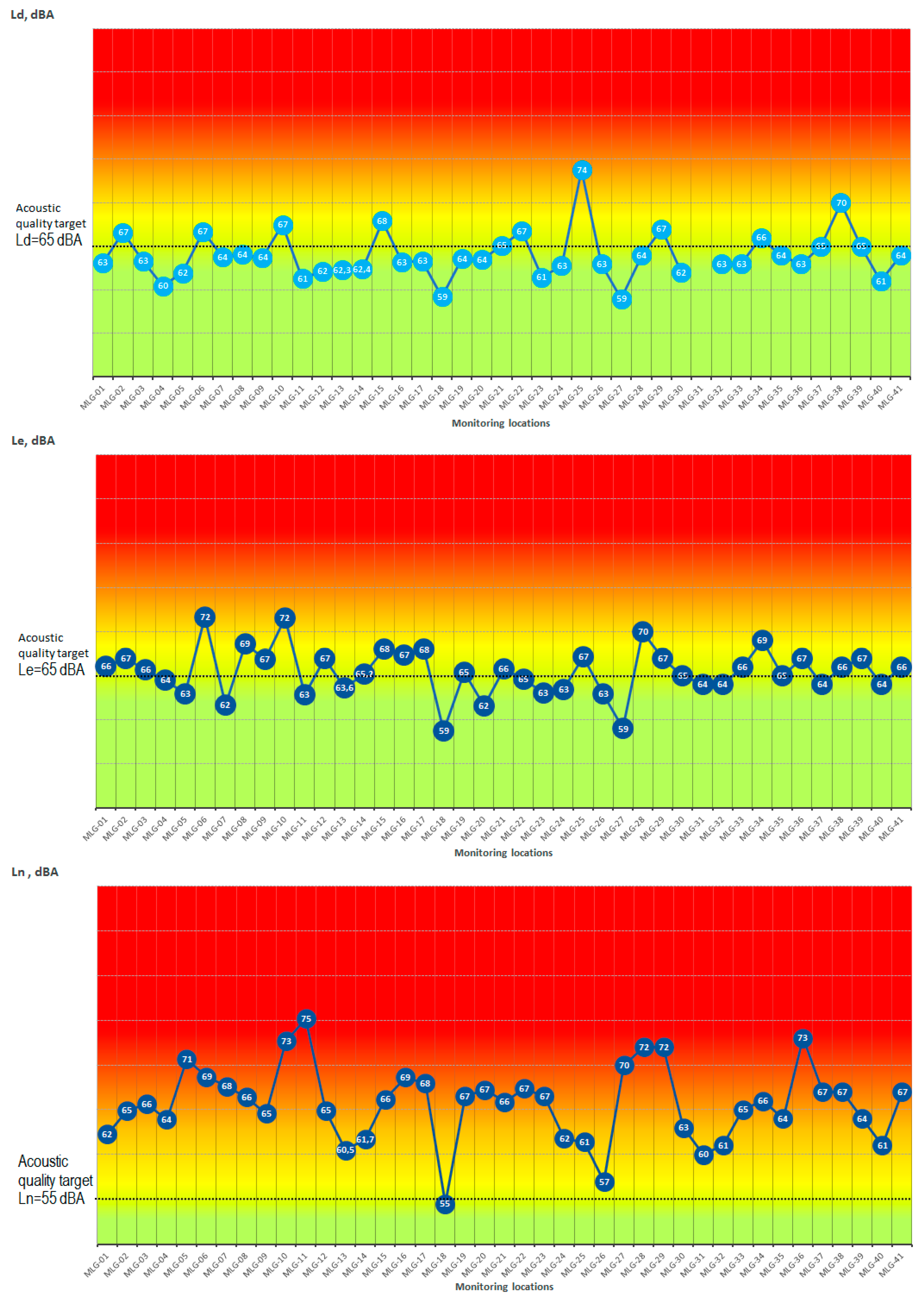
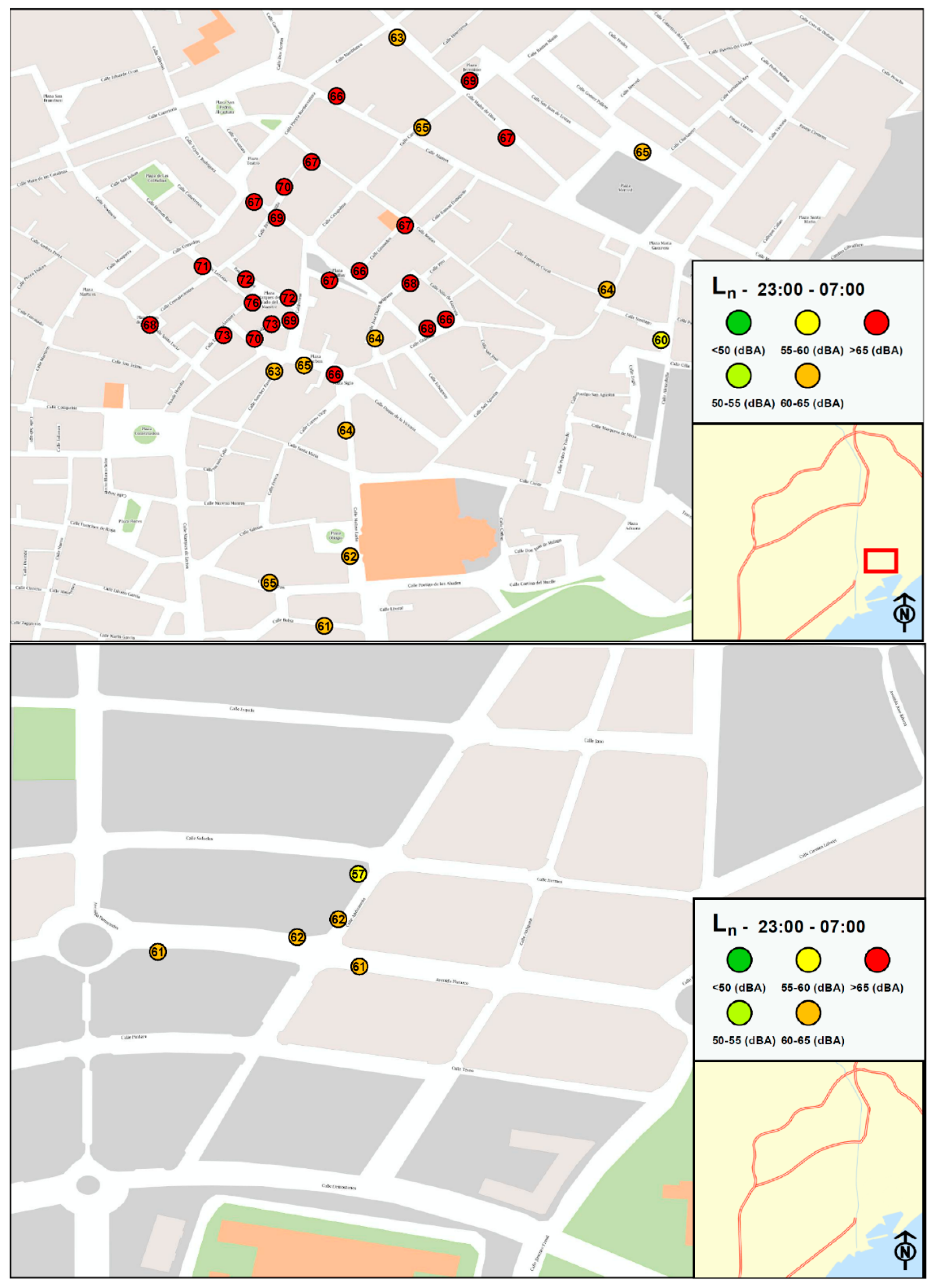
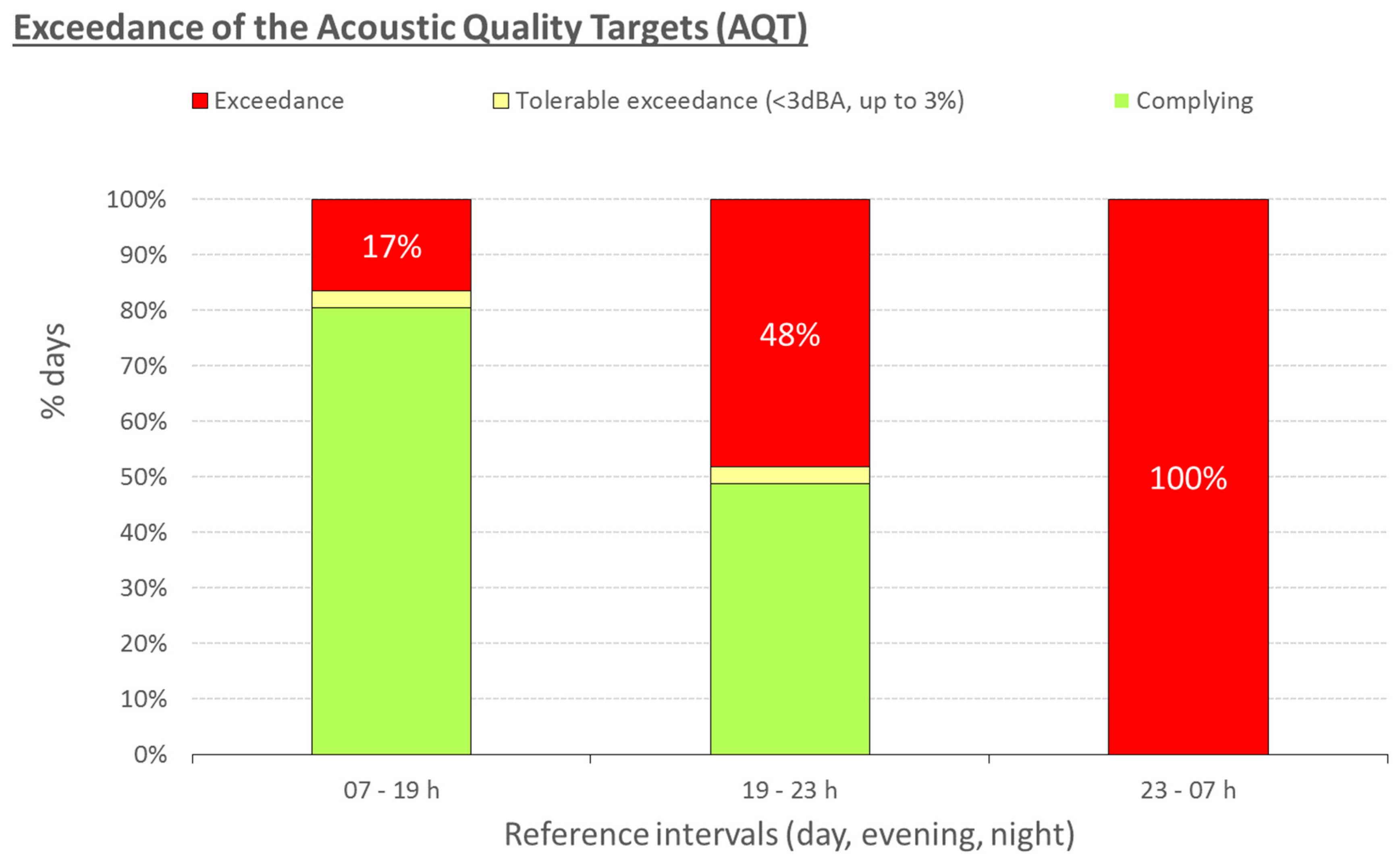
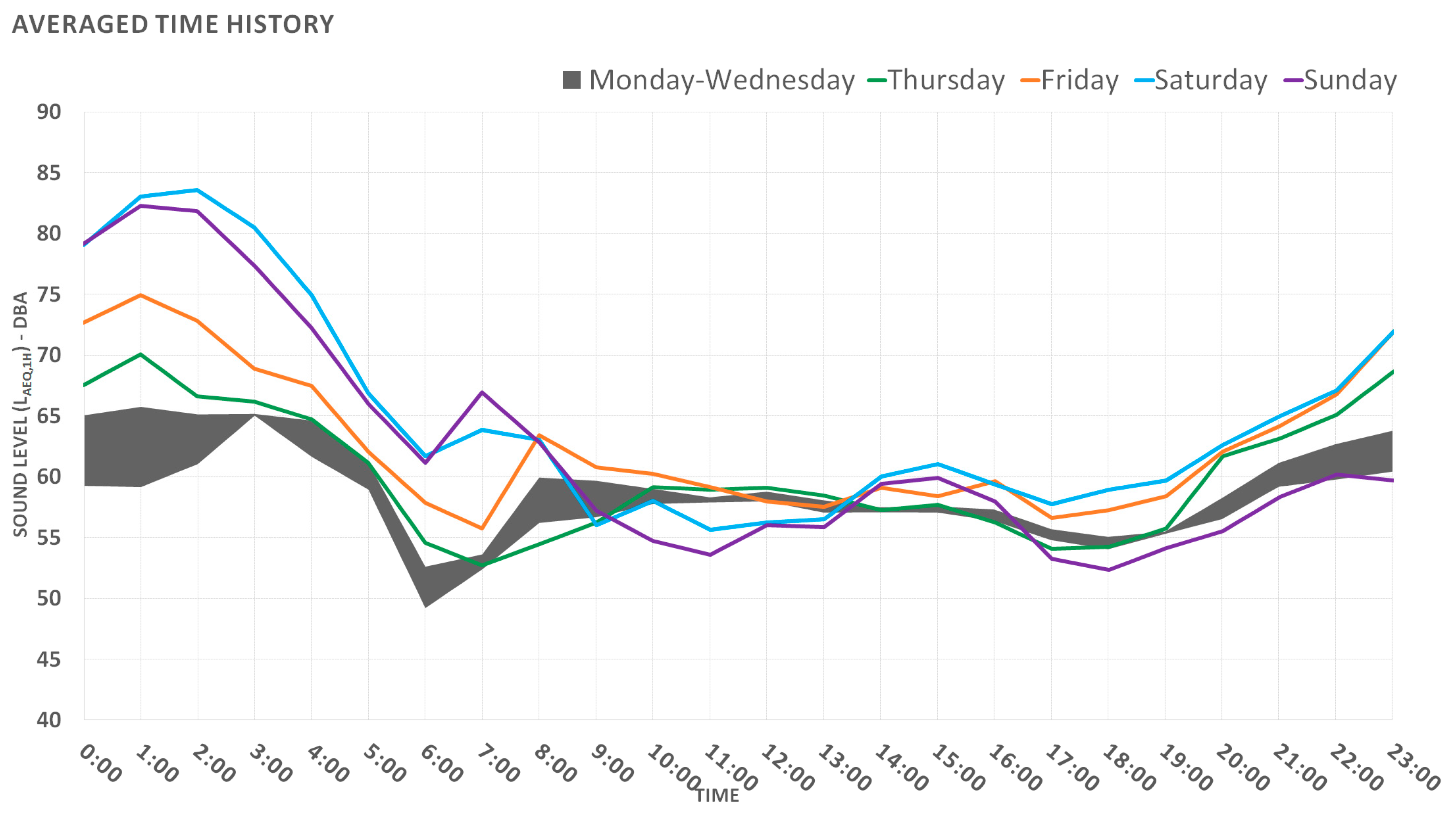
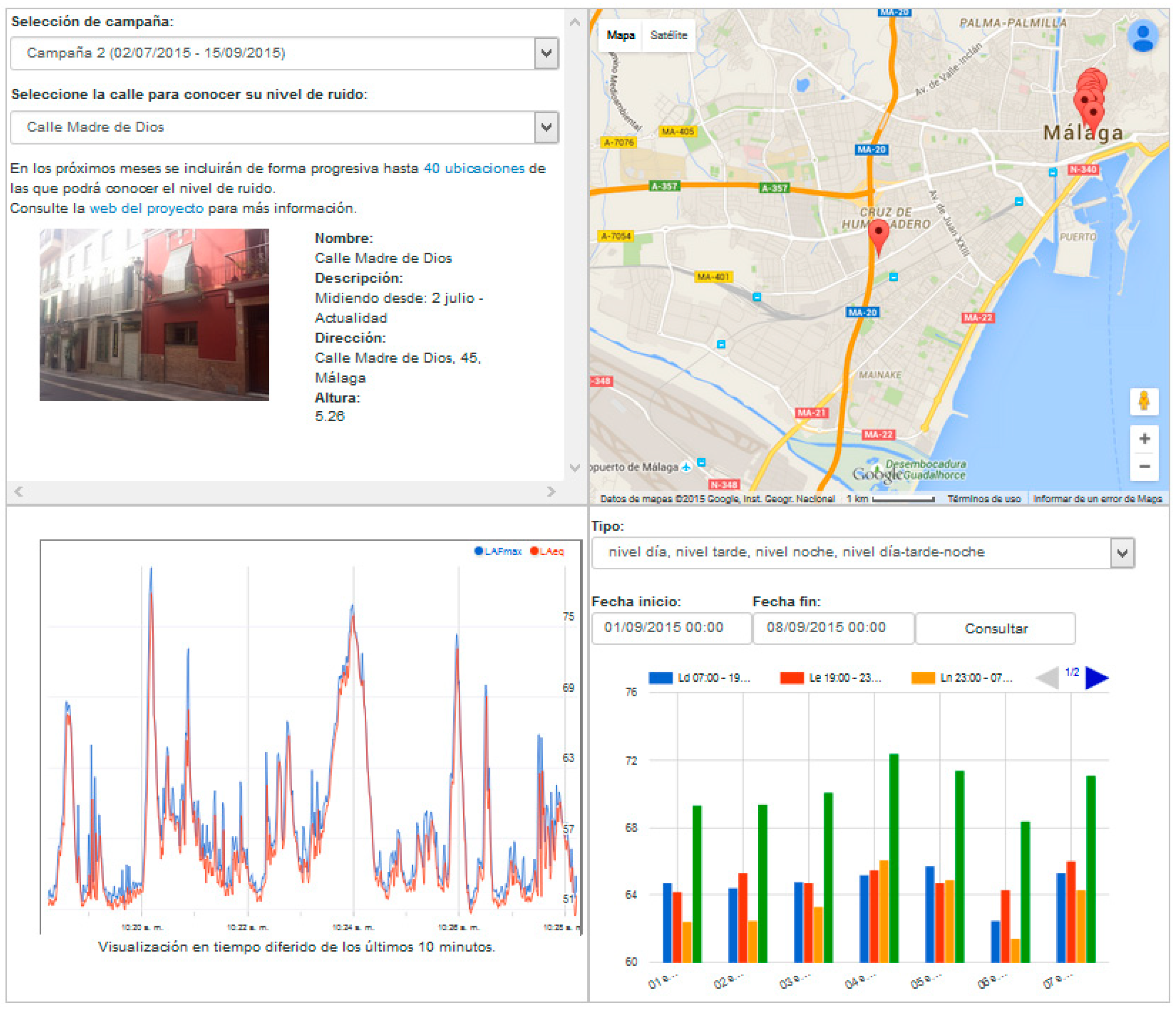
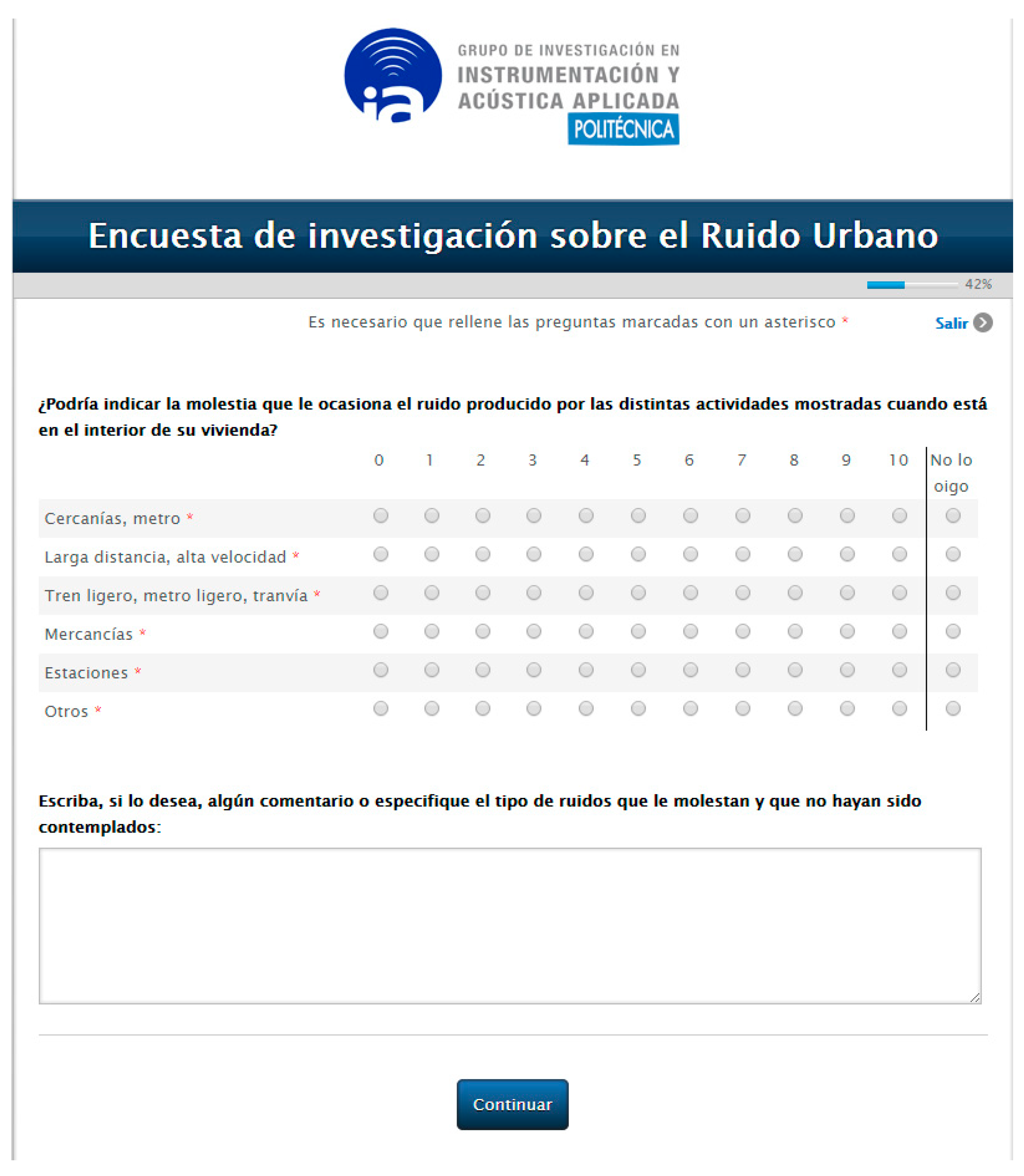
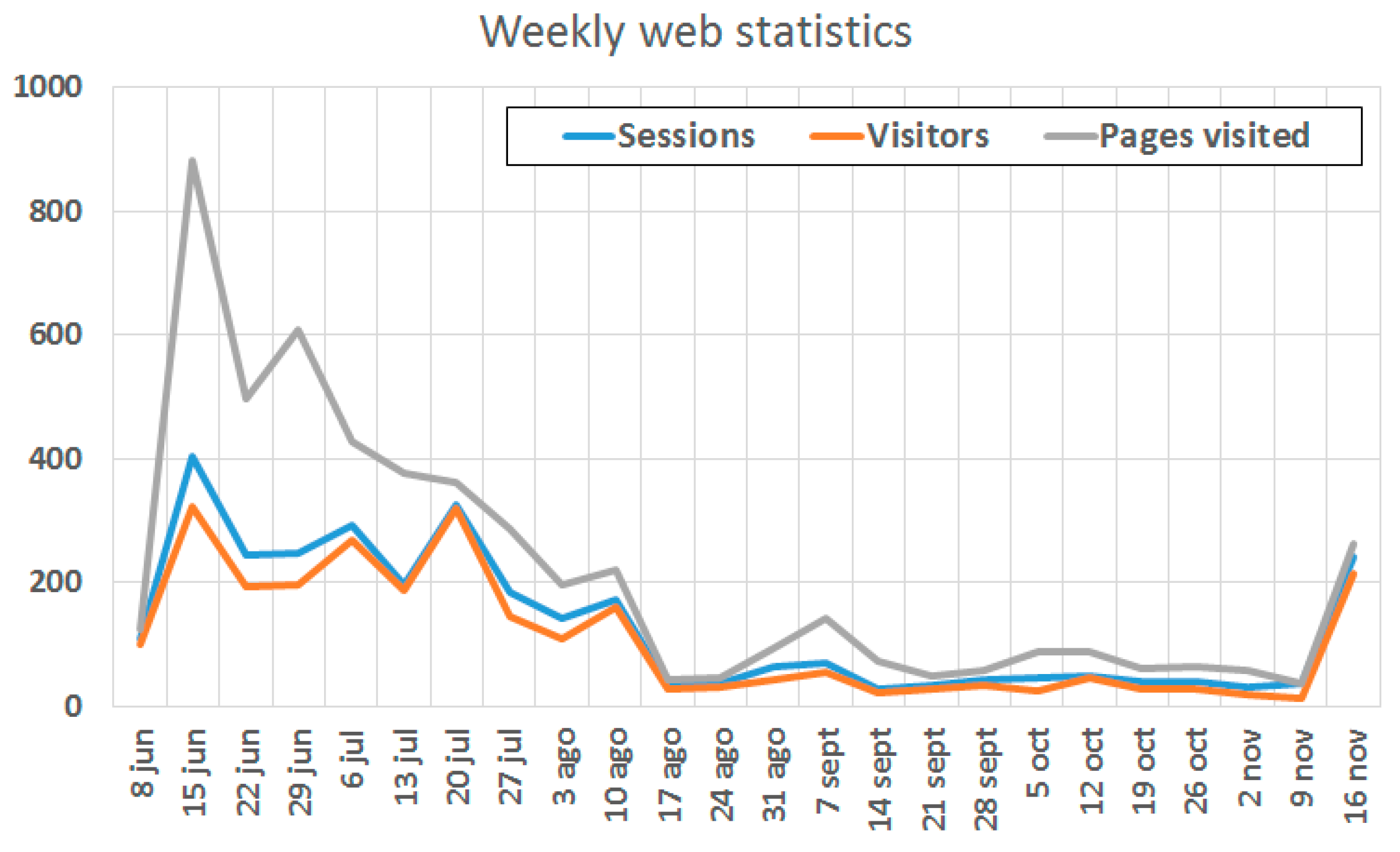
| Measurement Period | Area | Number of Units | Weeks of Measurement |
|---|---|---|---|
| April–June 2015 | City Center | 9 | 10 |
| May–September 2015 | City Center | 3 | 18 |
| May–November 2015 | Teatinos | 2 | 24 |
| July–September 2015 | City Center | 10 | 11 |
| October–November 2015 | Teatinos + City Center | 16 | 8 |
| Model (dBA) | Mean Error (dBA) | Standard Error (dBA) | |
|---|---|---|---|
| Models by Ballesteros | Lsaturday = 62.79 + 7.39 ln (N) | −1.3 | 4.7 |
| Lsaturday = 64.78 + 6.94 ln (0.8B + P + 2D + 0.6R) | −1.2 | 4.2 | |
| Lsaturday = 65.30 + 6.66 ln (P + 0.8B + 2D + 0.6R) + 25.81/W − 63.19/H | −0.3 | 3.1 | |
| Gaussian model | Lsaturday = 72.4 (N = 28 locations) | 0 | 3.6 |
| Lsaturday = 72.4 (N = 40 locations) | 0 | 4.2 | |
| Gaussian Model (dBA) | Standard Error (dBA) | 95% Coverage Interval (dBA) | Acoustic Quality Target (dBA) |
|---|---|---|---|
| Ld = 64.0 | 2.9 | [58.2; 69.8] | 65.0 |
| Le = 65.5 | 2.8 | [59.9; 71.1] | 65.0 |
| Ln = 66.0 | 4.0 | [58.0; 74.0] | 55.0 |
| Question | Results |
|---|---|
| How noisy do you consider your neighborhood? (0 Absolutely quiet–10 Extremely noisy) | Mean score = 8.8 54% of participants scored 10 (extremely) |
| Thinking of the last 12 months, when you are inside your dwelling, how much are you annoyed or disturbed by the noise from the street? | 87.9% Much or extremely |
| How much are you bothered or annoyed by the leisure noise? (0 nothing at all—10 Extremely) The participant had to rate different noise sources, but in this table, we focus on leisure noise | Mean score = 7.4 54% of participants scored 10 (extremely) |
| Would you consider noise as a problem in your life? | 88% of participants answered Yes |
| Could you rate to which extent noise in this area damages your quality of life? (0 Nothing at all–10 Absolutely) | Mean score = 8.1 36% of participants scored 10 |
| Do you consider that the noise situation in your dwelling is better or worse than 5 years ago? | 64% of the participants considered the situation much worse than 5 years ago |
| Thinking of approximately the last 12 months, could you indicate which of the following noise sources affects you most while you are in your dwelling? | 55% Leisure activities (bars, shows, sports) 14% Road traffic 9% City services 22% Other noise sources |
| Regarding leisure noise, and thinking of approximately the last 12 months, how much do you feel annoyed by the following activities when you are in your dwelling? (This question was only presented to those selecting leisure activities in the previous question) | Bars, restaurants, terraces. Mean score = 9.6 Crowds linked to bars. Mean score = 9.8 The rest of noise sources scored under 7.0 |
© 2018 by the authors. Licensee MDPI, Basel, Switzerland. This article is an open access article distributed under the terms and conditions of the Creative Commons Attribution (CC BY) license (http://creativecommons.org/licenses/by/4.0/).
Share and Cite
Asensio, C.; Gasco, L.; De Arcas, G.; López, J.M.; Alonso, J. Assessment of Residents’ Exposure to Leisure Noise in Málaga (Spain). Environments 2018, 5, 134. https://doi.org/10.3390/environments5120134
Asensio C, Gasco L, De Arcas G, López JM, Alonso J. Assessment of Residents’ Exposure to Leisure Noise in Málaga (Spain). Environments. 2018; 5(12):134. https://doi.org/10.3390/environments5120134
Chicago/Turabian StyleAsensio, Cesar, Luis Gasco, Guillermo De Arcas, Juan Manuel López, and Jesus Alonso. 2018. "Assessment of Residents’ Exposure to Leisure Noise in Málaga (Spain)" Environments 5, no. 12: 134. https://doi.org/10.3390/environments5120134
APA StyleAsensio, C., Gasco, L., De Arcas, G., López, J. M., & Alonso, J. (2018). Assessment of Residents’ Exposure to Leisure Noise in Málaga (Spain). Environments, 5(12), 134. https://doi.org/10.3390/environments5120134





